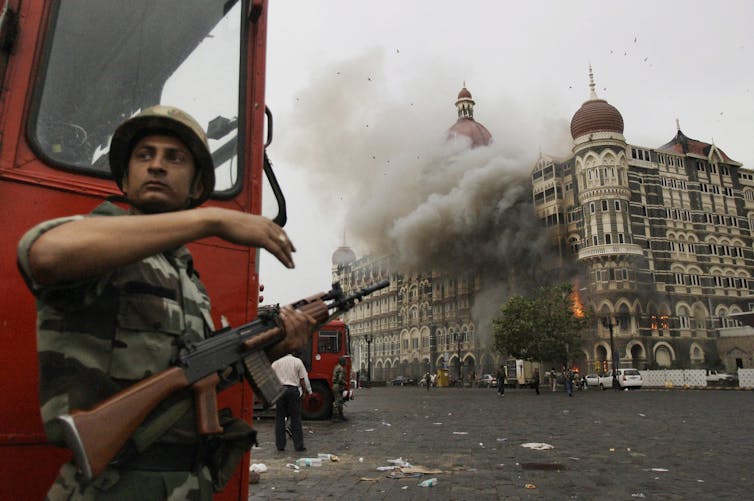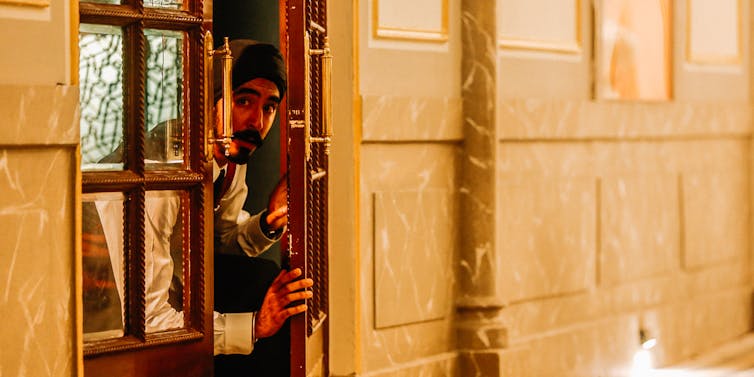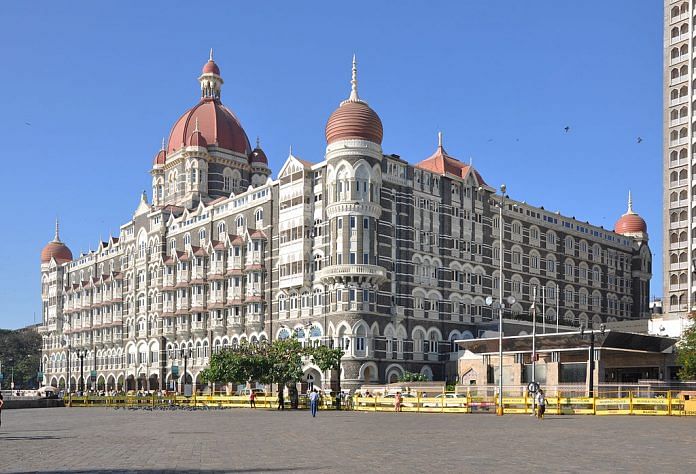Director Anthony Maras’ new film replicates the confusion, panic and genuine fear during the terror attack.
Director Anthony Maras’ new film Hotel Mumbai had its world premiere at the Toronto International Film Festival. The film stars Dev Patel (Slumdog Millionaire), Armie Hammer (Call Me By Your Name), Jason Issacs (Harry Potter) and Anupam Kher (The Big Sick). All of these actors attended the premiere and participated in a compelling Q&A conversation with the audience after the film.
The movie depicts the Mumbai terror attacks that took place 26 – 29 November 2008, when 10 gunmen belonging to the Pakistan-based militant organization Lashkar-e-Taiba staged a series of co-ordinated attacks across the city, ending with a multi-day siege of the luxurious Taj Mahal Hotel that left 164 dead and hundreds wounded.
Based on hundreds of hours of interviews with survivors and witnesses and told from the perspective of hotel guests, staff and to some extent the gunmen, the film sets out to recreate the attacks faithfully and authentically.
The film expertly ratchets up tension and confusion, drawing the viewer into a harrowing experience that is not broken up by lengthy plot digressions or exposition.

Hotel Mumbai provides a raw and rare look behind the curtain of a terrorist attack, inviting the audience to experience its unrelenting and gut-wrenching reality. The film doesn’t concern itself with the contextual details that emerge in the aftermath of a terror plot; instead it replicates the confusion, panic and genuine fear one would feel at the time.
For almost the entire two hour run-time, the viewer is left to struggle with the intensity of that confusion, not knowing when or if safety will materialize.
Since 11 September 2001, popular media in North America has moved from amorphous representations of political violence to a plot format that explicitly uses terrorism, invokes real militant groups and focuses almost exclusively on the United States and Islamic extremism as their bread and butter. Few films actually take the viewer inside the experience of terror plots as they happen; this is where Hotel Mumbai ushers in a new complex path with audiences.
The only potential drawback of this narrative style is that for viewers unfamiliar with the broader political context of terrorism in India — and in Western audiences they may be the majority — there is little information about where the attack comes from or how it fits into the larger story of the Indian subcontinent.
Terrorism in India
The Mumbai gunmen were trained in Pakistan and, as depicted in the film, carried out their attack with direction via mobile phones from planners in Pakistan’s metropolis port, Karachi. The gunmen were found to be members of Lashkar-e-Taiba (LeT), a Pakistan-based militant group that was also responsible for a 2001 attack on the Indian Parliament in New Delhi.
The existence of groups like LeT is a significant sore spot in India-Pakistan relations. India accuses Pakistan of enabling or even encouraging such groups and Pakistan consistently denies these allegations.
LeT emerged out of the radicalization of the Kashmir conflict — a territorial dispute between India and Pakistan over which country has the right to govern the Muslim-majority Kashmir valley. This conflict began with the 1947 partition of British colonial India into the two sovereign nations of India and Pakistan and has gone through numerous phases of escalation and détente.
India’s continued military presence and the human rights abuses carried out by security forces in Kashmir provide a major source of grievance to some Indian and Pakistani Muslims. Although India is home to the second largest Muslim population in the world after Indonesia, Muslims in India are heavily disadvantaged in comparison to the Hindu majority. They also experience higher rates of poverty and lower literacy levels.
Despite this, the vast majority of Muslims — whether in India or elsewhere — consistently reject religious extremism.
Everyday heroism
As a suspenseful and emotional snapshot of the events of November 2008, the film certainly succeeds. The audience’s applause felt genuine and visceral, not polite or obligatory. The cast themselves were visibly emotional on stage, notably when Maras revealed that one of the real-life survivors of the attack portrayed in the film was present in the audience. This survivor (unnamed here to avoid spoilers) received an immediate and emotional standing ovation.
The film is full of heroes, but not the kind that audiences are accustomed to seeing in movies about terror attacks. In Hotel Mumbai, heroes can die with the casual and unceremonious pulling of a trigger, just like anyone else. Though the film uses character archetypes, it does so in a way that disrupts common film tropes associated with the genre.
For example, the local police are brave but are hopelessly outgunned and out of their depth when faced by trained insurgents with automatic weapons. Armie Hammer’s character, the white American male that so often saves the day in Hollywood blockbusters, spends most of the film wanting to protect his family but having no real idea how to do so.
By contrast, Anupam Kher’s Chef Oberoi displays a quiet dignity by relinquishing his opportunity for escape in favour of protecting the hotel guests by calmly hosting them in one of the hotel’s hidden lounges. Dev Patel, as always, gives a memorable performance as a hotel staff member who just wants to get back to his family but displays remarkable courage and compassion along the way.

Just as there is no Hollywood action hero ready to jump in and save the day, Hotel Mumbai also steers clear of depicting the kind of one-dimensional villains that dominate most films in the spy or terrorism genres. The attacks in the film (as in real-life) are brutal, shocking and almost casual in their indifferent disregard for human life.
But the gunmen themselves remain undeniably human. In one scene, we see the terrorists coldly gunning down unarmed civilians and in the next we see them teasing each other about whether there is pork in the canapés. Later, we see the inner conflict of one of the gunmen, who seems to be in over his head as he oscillates between crippling self-doubt and brutal determination.
It is the dissonance between these two dimensions that make this depiction of terrorism so compelling. We also see how the attack impacts each of the attackers in subtly different ways, reinforcing that each has been drawn into this act of horrific violence through their own distinct motivations, whether religious, political or socio-economic.
It is not necessarily that the gunmen in this movie are relatable or sympathetic in the traditional sense (for the most part they are not), but they are resolutely human and that is part of what makes their violence so disturbing. The viewer is asked to face the uncomfortable truth that the people who carry out these attacks might not be the monsters hiding in the shadows that we so often see depicted on screen, but are simply ordinary people carrying out extraordinary acts of brutality.
Despite the horror that this film paints with such gritty and meticulous attention to detail, Hotel Mumbai is ultimately not about violence as an act that is carried out upon passive victims. Instead, it is about the resistance, resilience and quiet heroism of people confronted by chaotic scenarios filled with impossible choices.
Rising terrorism on ‘soft targets’
The film asks us to challenge easy assumptions and to rethink any sensationalist preconceptions we may hold about how we would, or would not, react in such a crisis.
Hotel Mumbai feels every bit as relevant today as if it had been released back in 2008 when the attacks occurred. If anything, the passage of a decade has perhaps made the tragedy of the Mumbai attacks resonate even more strongly with international audiences.
Massacres carried out by armed gunmen in “soft targets” such as hotels, train stations and shopping malls have become depressingly common in recent years.
Historically most of al-Qaida’s most well-known attacks have used explosives, making them devastating in their death tolls but also relatively difficult to plan and execute.
Since 2014, ISIS has popularized the strategy of using any and all weapons available to attack public spaces, making attacks carried out by their sympathizers incredibly challenging to prevent. This style of attack is widespread across the ideological spectrum with notable examples including the Norway massacre of 2011 and the Las Vegas shootings of 2017.
Hotel Mumbai is ultimately intended as an “anthem of resistance” for those who survive such attacks, a quiet memorial of those who don’t and a sobering snapshot of the chaos of terrorism for those who, fortunately, have never found themselves inside its brutal plot.
is an SSHRC Postdoctoral Fellow at the University of Toronto, and is a Doctoral Candidate and Teaching Fellow at Queen’s University, Ontario.
This article was originally published in The Conversation.




I think it is better if the authors confine themselves to talking about the film and stop their gratuitous half-baked analysis of background of terrorism or origins of LeT. The authors are not Indians or Persons of Indian Origin, and it is quite clear they know nothing about India or its blood drenched history, (where it has to handle repeated invasions), and they even seem to know less about the origins of the deep state of Pakistan or Pakistan backed terrorism in India.
Let me see if the theprint is transparent enough to post my comment
The authors linking the Pakistani infiltrators, their brutal attack in Mumbai to Kashmir or living conditions of Indian Muslims is ludicrous.
It is well known, that LeT is a political Islamic entity , subscribes to the ideology of Political Islam, and that it almost functions as a covert arm of Pakistani Army, and their intentions is to basically invade entire India and force Islamic Rule over the entire country, It is also well known that they covet the water resources in Indian state of J&K. In short, they do not have a single agenda item of just J&K, though muslim majority J&K being part of India, is used for motivating terrorists
The mention about Kashmir and alleged human rights abuses by India is laughable and one-sided . Pakistan invading the independent state of Kashmir is never mentioned. J&K irrevocably acceding to India, to escape the invasion by Pakistan is not mentioned. After Occupying and retaining a third of J&K, the demographic Invasion of Pakistani Occupied Kashmir (PoK) over the past 8 decades, where Indigenous Kashmiris have been reduced to a minority has never been mentioned. The fact that, indigenous Kashmiris in PoK have never been given self-rule and there are no functioning democracy there, and there are periodic protests on this is also not mentioned.
Also not mentioned is the Water dimension, which is that despite India being generous in giving over 70% percent of Indus water basin to Pakistan (the most generous trans-national water treaty in the world) , the Pakistani desire to invade and forcibly take control of the origins of the water supply of the Indus River Basin, and Pakistani attempts to deny legitimate desire of Indian state of Jammu and Kashmir to use the water resources in its state. Also not mentioned is Pakistani attempts to infiltrate terrorists in Indian state of J&K, brutally Kill anyone who wants development and normal relations with federal government in Delhi. Not mentioned is the ethnic cleansing of half a million Minority Hindus and Sikhs in Indian state of J&K. India has soldiers inside J&K (apart from Border) to protect Minorities who have fled to Jammu region and also protect Kashmiris from Pakisstani infiltrators, who terrorize them. This is not mentioned. Not mentioned is the war waged by the infiltrators on the syncretic Sufi Islamic traditions of Kashmir over the past three decades. To get continued local support from Indigenous Kashmiris, the Pakistani terrorists/infiltrators, have forced Talibani dictats on the womenfolks there and have ensured complete radicalization, that includes a call to Political Islam and Islamic State. This recent transformation of youngsters to the cause of Political Islam is not mentioned.
India is a country with maximum number of poor people (belonging to all religions), backwardness in human development indices (belonging to all religions) and the country as a whole wants to lift itself out of poverty. The Majority of the Indian citizens are resolute in their determination of the same. What is the relevance of Indian Muslims in a discussion about a Movie, based on a real-life incident involving Pakistani Terrorists, supported by the Pakistani Deep State, who wantonly and brutally kill unarmed civilians (Indians and Foreigners) ?
It has now been seen the world over (Islamic state, Muslim brotherhood etc..) that key terrorists and the masters are highly educated, use Political Islamic ideology & Islamic Rule by Sharia, conversion of Non-muslims (especially women), with alleged threat to Islam as motivation, and NOT poverty. Terrorism is also perpetrated in Islamic countries against those who do not believe in Political Islam. The fact is that Non-muslim population has drastically declined in Islamic countries especially Pakistan and Bangladesh. However, Muslim population has grown in India. Foot soldiers are recruited to carry out the acts using any means possible (Vision of Islamic rule by Caliphate I and Political Power, fomenting religious tensions to propagate Islam under threat narrative, tapping into the alienation of Muslim youths in Ghettos of Europe, OR blatant intimidation of young Muslims in Afghanistan, PoK, Indian state of J&K, and monetary incentives in Africa,Pakistan)
Among others, the film itself has ONE BIG Gaping Flaw, it NEVER names the terrorists as originating from Pakistan, which is a known fact. Any reasonable commentator would have caught this deficiency and highlighted the same.
Am surprised that University of Toronto and Queen’s university, which are well known universities, have hired such folks on their rolls, who do not have sufficient understanding of basic history of Foreign (to Canada) countries, and are prone to one-sided arguments, along with sweeping generalizations.